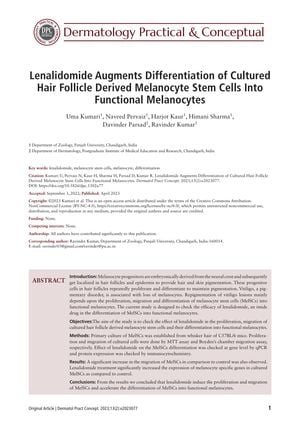Lenalidomide Augments Differentiation of Cultured Hair Follicle Derived Melanocyte Stem Cells Into Functional Melanocytes
April 2023
in “
Dermatology practical & conceptual
”
lenalidomide melanocyte stem cells MelSCs melanocytes hair follicles proliferation migration differentiation MTT assay Boyden chamber migration assay qPCR immunocytochemistry Revlimid stem cells hair roots cell growth cell movement cell specialization MTT test migration test gene expression analysis protein staining

TLDR Lenalidomide helps hair follicle stem cells turn into melanocytes, which may improve repigmentation in vitiligo.
The study investigated the effect of lenalidomide, an imide drug, on the proliferation, migration, and differentiation of melanocyte stem cells (MelSCs) derived from mouse hair follicles into functional melanocytes, which are crucial for repigmenting vitiligo lesions. Primary cultures of MelSCs from C57BL/6 mice whisker hair were treated with lenalidomide, and their proliferation and migration were assessed using MTT assay and Boyden chamber migration assay, respectively. The differentiation of MelSCs into melanocytes was evaluated at the gene level by qPCR and at the protein level by immunocytochemistry. The results showed that lenalidomide significantly increased the migration of MelSCs and upregulated the expression of melanocyte-specific genes compared to the control, leading to the conclusion that lenalidomide enhances the proliferation, migration, and differentiation of MelSCs into functional melanocytes.





